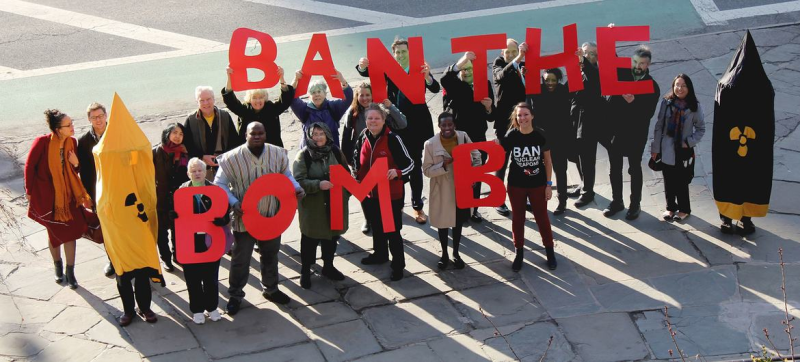- Ctg Port’s historic milestone in 2025 container handling, revenue |
- NBR Probes Bank Records of 100 Exporters Over Bond Abuse |
- Hadi murder case: Sanjay, Faisal give ‘confessional’ statements |
- Islami Bank organizes orientation for 1000 Trainee Assistant officers |
- 2025: People’s Resistance Against Hydro Projects in Himalaya |
UN Renews Push for Global Elimination of Nuclear Arms

Protestors voice their opinion about nuclear weapons.
Nuclear weapons continue to pose an existential threat to humanity. On Friday in New York, as high-level week draws to a close, world leaders will revisit the grave dangers these weapons pose and push for renewed global efforts to eliminate them.
In the final days of the Second World War, as the idea of the United Nations was beginning to take shape, the atomic bombings of two Japanese cities sent a chilling warning to the world of the terrifying destructive power of nuclear weapons. Eight decades later, amidst rising geopolitical tensions and ongoing conflicts, the threat from nuclear arms is escalating.
In his message for the International Day for the Total Elimination of Nuclear Weapons, observed annually on 26 September, UN Secretary-General António Guterres reminded the world that “nuclear weapons deliver no security – only the promise of annihilation.”
Nuclear disarmament has remained a top priority for the UN since its inception. In fact, the very first resolution adopted by the UN General Assembly in 1946 focused on nuclear disarmament.
In the decades that followed, the UN continued to lead diplomatic efforts in this direction. In 1959, the General Assembly formally supported the goal of general and complete disarmament. In 1978, the first Special Session of the General Assembly on Disarmament declared nuclear disarmament to be the highest priority.
Every UN Secretary-General has actively pursued this goal. The current incumbent, António Guterres, has repeatedly warned that “geopolitical tensions and mistrust have escalated the risk of nuclear warfare to its highest levels in decades.”
“These weapons are growing in power, range, and stealth. An accidental launch is one mistake, one miscalculation, one rash act away,” he told the Security Council last year.
Although nuclear weapons have only been deployed twice, their shadow still hangs over humanity. Over 12,000 nuclear warheads still exist today. Their destructive potential threatens entire cities, millions of lives, the environment, and future generations.
More than 50 per cent of the world’s population lives in countries that either possess nuclear weapons or are part of nuclear alliances. Concerns over their possible use have intensified due to conflicts, including the war in Ukraine.
Many nuclear-armed countries are also planning to modernise their arsenals. The integration of emerging technologies, such as artificial intelligence, raises the possibility of misjudgements and misunderstandings, making the risks even more complex and unpredictable.
Over the decades, a range of multilateral treaties and initiatives have been established to curb, regulate, or eliminate nuclear weapons, helping to slow proliferation and advance disarmament.
However, rising global instability and violent conflicts are placing increasing pressure on these mechanisms. The weakening of such frameworks risks sparking a renewed nuclear arms race.
In 2019, the United States announced its withdrawal from the Intermediate-Range Nuclear Forces Treaty, which targeted the elimination of a specific class of nuclear missiles. In 2022, a major review conference failed to reach consensus on the Nuclear Non-Proliferation Treaty.
The following year, Russia withdrew its ratification of the Comprehensive Nuclear-Test-Ban Treaty (CTBT) and suspended its participation in the New START Treaty on measures for the reduction and limitation of strategic offensive arms.
These developments have led to growing frustration over the slow pace of disarmament and rising concern about the catastrophic potential of even a single nuclear detonation. Since the end of the Cold War, while the number of deployed nuclear weapons has decreased, not a single nuclear warhead has been eliminated as a result of any treaty. Nor are there any active negotiations currently aimed at nuclear disarmament.
To mark this year’s International Day for the Total Elimination of Nuclear Weapons, a high-level meeting is being held on Friday, 26 September, as high-level week of the General Assembly draws to a close.
This initiative, established by a resolution passed in 2013, is designed to raise public awareness, foster global dialogue on disarmament, highlight the benefits of a nuclear-weapon-free world, and draw attention to the costs of maintaining such weapons.
The gathering is expected to mobilise international support for a world free of nuclear weapons and reassert commitment to disarmament and non-proliferation, especially on the historic occasion of the UN’s eightieth anniversary.

